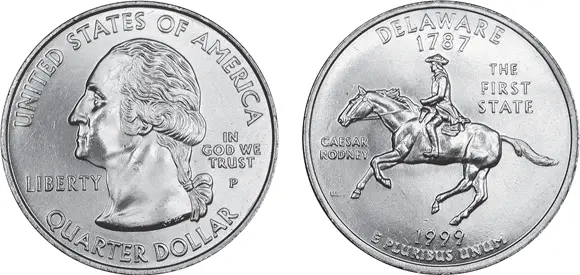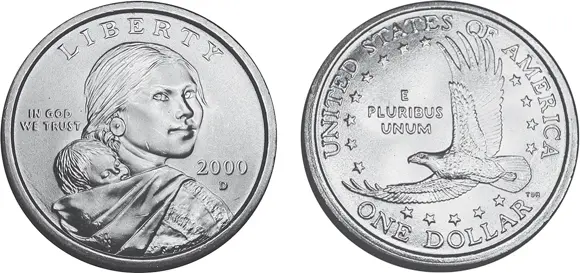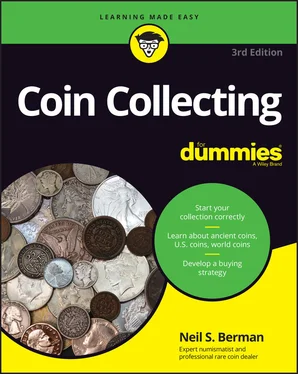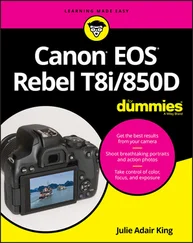Neil S. Berman - Coin Collecting For Dummies
Здесь есть возможность читать онлайн «Neil S. Berman - Coin Collecting For Dummies» — ознакомительный отрывок электронной книги совершенно бесплатно, а после прочтения отрывка купить полную версию. В некоторых случаях можно слушать аудио, скачать через торрент в формате fb2 и присутствует краткое содержание. Жанр: unrecognised, на английском языке. Описание произведения, (предисловие) а так же отзывы посетителей доступны на портале библиотеки ЛибКат.
- Название:Coin Collecting For Dummies
- Автор:
- Жанр:
- Год:неизвестен
- ISBN:нет данных
- Рейтинг книги:4 / 5. Голосов: 1
-
Избранное:Добавить в избранное
- Отзывы:
-
Ваша оценка:
- 80
- 1
- 2
- 3
- 4
- 5
Coin Collecting For Dummies: краткое содержание, описание и аннотация
Предлагаем к чтению аннотацию, описание, краткое содержание или предисловие (зависит от того, что написал сам автор книги «Coin Collecting For Dummies»). Если вы не нашли необходимую информацию о книге — напишите в комментариях, мы постараемся отыскать её.
Coin Collecting For Dummies,
numismatics
Coin Collecting For Dummies
Coin Collecting For Dummies — читать онлайн ознакомительный отрывок
Ниже представлен текст книги, разбитый по страницам. Система сохранения места последней прочитанной страницы, позволяет с удобством читать онлайн бесплатно книгу «Coin Collecting For Dummies», без необходимости каждый раз заново искать на чём Вы остановились. Поставьте закладку, и сможете в любой момент перейти на страницу, на которой закончили чтение.
Интервал:
Закладка:

FIGURE 2-4:The 1999 Delaware Quarter — first of the 50 State Quarters.
Sacagawea dollar
In what was perhaps the biggest and most expensive advertising campaign ever for a new coin, the U.S. Mint introduced a new $1 coin in 2000. The new dollar (shown in Figure 2-5) featured the Native American guide Sacagawea and her infant son on the front, and an eagle on the back. To make the coin distinctive, the edge was left flat and plain, and the entire coin was struck from an alloy the color of gold. In a stroke of genius, the U.S. Mint contracted with Walmart stores throughout the country to distribute the new coins in limited quantities. Banks received very few of the coins, creating the false impression that the new coins were rare. In fact, billions of the Sacagawea dollars have been produced, so they’ll never be rare, but try to find one at your local bank or retail store. On top of that, many people thought the coins were made of real gold!

FIGURE 2-5:The 2000 Sacagawea dollar.
The public gobbled up these coins like crazy and locked them away in their sock drawers and safe-deposit boxes. Many of these hoarders have discovered the joys of numismatics and are now actively involved in collecting other coins as well.
New commemorative issues
In the “ Commemorative coins” section earlier in this chapter, I mention abuses in the commemorative coin programs in the 1930s. Collectors in the 1940s and 1950s had a few commemorative coins to choose among, but collectors in the 1960s and 1970s were left high and dry. In 1982, the U.S. Mint began issuing commemorative coins again on a tentative basis. Today, the mint has hit its stride, issuing one or more commemorative coins each year in a variety of metals, set combinations, and price levels. New commemorative coins are available in gold, silver, and copper–nickel on subjects that appeal to a broad audience. Each new issue creates excitement among existing collectors and brings new collectors into the hobby, but the large mintages make it unlikely that the coins will increase in value. (See Chapter 13to find out more about the many interesting commemorative coins issued by the U.S. government.)
Error coins
We give the U.S. Mint a lot of credit for a job well done. It reintroduced the Susan B. Anthony dollar, created and marketed the incredibly popular Sacagawea dollar, came up with 40 new quarter dollar designs in eight years, and worked around the clock to strike billions and billions of coins so that we can go out and spend them. As coin collectors and dealers, we owe a debt of gratitude to the U.S. Mint for doing something I’ve been trying to do for decades: getting people interested in numismatics.
I don’t say that mints are perfect. In fact, I acknowledge that the U.S. Mint is far from perfect. But as far as numismatics goes, imperfection is a good thing. Few industries have product lines in which the rejected items are more valuable than the perfect ones. Bad light bulbs get thrown away, imperfect clothing is sold as seconds, and defective washing machines sell in classified ads. None of them fetches a premium — certainly not the tens of thousands of dollars that some coin errors have brought.
In 2000, several spectacular error coins stunned the numismatic world. One such error was a coin with the front of a 50 State Quarter and the back of a Sacagawea dollar — the first U.S. coin ever to bear two denominations. Because the two dies differ in diameter, no one believed that it was possible for such an error to exist; in fact, some professionals believe that these error coins were made deliberately. The error received tremendous publicity in the national media, causing millions of noncollectors to begin examining their change. You can bet that many of them have become coin collectors.
Error coins not only capture the essence of the manufacturing process but also one’s curiousity. More recently, an error on the strike of Lincoln Presidental Dollars omitted some edge lettering, which catapulted this coin to sell for as much as $500, depending on condition.
The Fred Weingberg Collection, known as one of the greatest modern day collections of U.S. mint errors, highlights a 2000-P Sacagawea dollar/Washington Quarter mule — one of the rarest mint errors — and a 1880-S Morgan dollar, graded MS63 by PCGS and struck 40 percent off center. Both of these coveted mint error coins are expected to capture a premium sum at a Heritage Auction in 2022.
Chapter 3
Arming Yourself with Knowledge
IN THIS CHAPTER
 Researching coins
Researching coins
 Determining a coin’s value
Determining a coin’s value
 Collecting what interests you
Collecting what interests you
On one hand, becoming a coin collector is easy. On the other hand, becoming a good collector requires some effort and planning. New collectors are often overwhelmed by language they’ve never heard before, concerns about counterfeit coins, grading issues, and so on. Unfortunately, there’s no Coin Collecting University … unless you count the School of Hard Knocks, where the tuition can be high and the classes are really tough. But you can study on your own and become quite knowledgeable in your own right.
In this chapter, I show you the importance of finding out what you need to know about coins, knowing where to go for advice, and establishing long-term collecting goals.
Gaining Knowledge Before You Buy
They say that if you give a person a fish, you feed them for a day, but if you teach a person how to fish, you feed them for a lifetime. You must learn the basics of fishing (in this case, coin collecting) before you make your first cast (your first coin purchase). That way, you’ll know why you’re “fishing,” what you’re “fishing” for, and what you’re going to do after you catch your first “fish!”
Understanding the parts and purpose of a coin
Before you start collecting coins, it helps to know what a coin is.
Coins have three sides. The front of the coin is called the obverse; the back, the reverse; and the edge is … well, the edge. Modern coins are usually struck (stamped) from dies, which are pieces of metal (usually steel) with designs on them. There are three dies: the obverse die, the reverse die, and the collar die (which strikes the edge). Engravers (artists with engraving tools) create the designs on the dies. In the past, this work was done entirely by hand, but now much of this process is automated. Legends and mottoes are the words that you see on both sides of a coin. Many of the designs and wording are required by law; others are included at the discretion of the designer and the minting authority.
Coins are struck at a mint, which usually is a government-run operation. The number of coins struck is called the mintage. Coins are struck for the following uses:
Читать дальшеИнтервал:
Закладка:
Похожие книги на «Coin Collecting For Dummies»
Представляем Вашему вниманию похожие книги на «Coin Collecting For Dummies» списком для выбора. Мы отобрали схожую по названию и смыслу литературу в надежде предоставить читателям больше вариантов отыскать новые, интересные, ещё непрочитанные произведения.
Обсуждение, отзывы о книге «Coin Collecting For Dummies» и просто собственные мнения читателей. Оставьте ваши комментарии, напишите, что Вы думаете о произведении, его смысле или главных героях. Укажите что конкретно понравилось, а что нет, и почему Вы так считаете.












